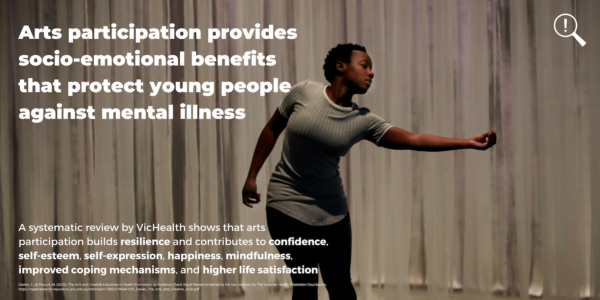Including research in your National Cultural Policy submission

As many of you know, the deadline is fast approaching for submissions to help inform the Australian Government’s new National Cultural Policy.
We’re writing today to remind you that research can be a hugely valuable tool in your advocacy toolkit.
Over the last few months, ATYP has been working with research agency Patternmakers to harness the existing research around the value of Youth Arts into a set of ‘key messages’ for the sector.
Along the way, we’ve found that the research about YPA comes in many different forms – from Randomised Control Trials, to Systematic Reviews, to Meta-Analyses, to Industry Evaluations – and that without research experience, it can be hard to judge what the best-quality sources are.
We know it can be hard to know where to start – we’re here to help! Below we’ve included 4 key arguments for the value of youth arts and some tips for gathering evidence from your network.
Using research responsibly
In order to ensure the case for YPA is truly ‘bulletproof’, it’s important to ensure we’re using research responsibly. When in doubt, always try to find the original paper or findings – rather than relying on other sources. Make sure you understand things like research type (quantitative or qualitative?), sample size (is it reasonably large?), authorship (does it come from a reputable organisation or research institution?), and relevance (was it published recently and in a similar context to yours?).
We’ve collected four high-impact findings below, with help from research agency Patternmakers:
Arts participation provides socio-emotional benefits that protect young people against mental illness
For example: Systematic reviews of the literature show that arts participation by young people builds resilience and contributes to confidence, self-esteem, self-expression, happiness, mindfulness, improved coping mechanisms, and higher life satisfaction.
For example: For every $1 invested in YPA, $7 is potentially saved in mental health investment, according to a study of the Social Return on Investment of a youth circus program conducted by Cirkidz and Uni SA.
Arts-rich learning contributes to academic outcomes
For example: An Australian longitudinal study of over 600 students showed that arts engagement significantly predicted class participation, educational resilience (the ability to deal with academic setbacks and adversity), and motivation.
For example: An Australian pilot study of over 1000 students, including 155 ATSI students, found that CAIPE, an arts-based educational intervention, ‘closed the gap’ in Indigenous students’ NAPLAN scores by more than 20% in reading and 17% in writing.
Telling stories
Case studies, testimonials, videos and photos are another fantastic tool in your arsenal – and you can count on your performers and their families to be some of your greatest advocates! But to get the right answers, you need to be asking the right questions.
Here are some tips for capturing the transformational impact of YPA:
- Always ask open-ended questions, and ensure you have a good balance of positive and negative in the case study. E.g. What was the best part? What could be improved?
- Use a problem/solutions framework. Did the arts help to overcome any challenges or obstacles? If so, how?
- Ask them to imagine, ‘what would be different if they hadn’t participated in YPA?’
- A helpful follow-up question can be, ‘why is that important?’ Let them do the work for you and unpack exactly why YPA has been so meaningful.
What next?
How you use these tools is up to you. You might want to use them to strengthen your submissions (and you can find a great how-to guide for submissions by NAVA and TNA here), to reflect on your practice, or for further advocacy work in future!
Patternmakers have created easily shareable banners for your use across social media here.
If you have any questions about the resources, you can contact Patternmakers at [email protected].


